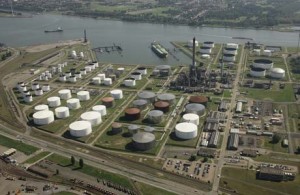The Global Refining Outlook published in mid-2014 by ESAI Energy indicated that global refiners will add nearly 2.0 million bpd of distillation capacity before the end of 2015. This compares to less than 300,000 bpd of capacity growth between 2013 – 2014. Many strategic planners could have anticipated this uptick in distillation capacity, particularly in Asia. The interesting “take-away” from this development is the large volumes of light crudes contributing to this volume gain, along with the refinery projects that were committed to based on the premise of exports.
The ESAI Energy study noted that big refinery projects in Saudi Arabia and the U.A.E. will lead to the addition of an anticipated 900,000 bpd of capacity in the Middle East. They noted that expanded refining capacity in OPEC Member Countries will come from new ‘grassroots’ projects, supplemented by expansions at existing facilities. The study found that the cumulative investment required for the realization of these projects to 2018 is estimated at around $60 billion. Many of these projects are focused on export oriented refineries.

European refiners are gaining access to a wide variety of crudes
The new narrative about U.S. crude and U.S. refinery exports competing with Middle East refinery exports gets more lively when we hear that Asian refiners are trying to diversify away from Middle East crude and refined product imports. Middle East refiners may face more competition than originally expected as Asian refiners try to reduce dependence on Middle East crude, whether heavy or light.
South Korea’s second largest refining organization, GS Caltex (GSC), announced March 9 that they have begun importing crude oil from Mexico for the first time in 24 years. According to a March 9 report in The Korea Times, GSC has previously imported nearly 84% of its crude oil from the Middle East and the remaining from the North Sea, Southeast Asia and the U.S. The March 9 report also noted that South Korea’s largest refiner, SK Innovation, has imported nearly 97% of its crude oil from the Middle East, which is one reason why they imported 400,000 barrels of crude from Alaska in 2014 as part of efforts to reduce its reliance on the Middle East.
Actually, Korean refiners have been buying tankers of Eagle Ford condensate since the summer of 2014. By September 2014, Japanese refiner, Cosmo Oil also began receiving 300,000 to 400,000 barrel shipments of U.S. condensate, an ultra-light hydrocarbon mixture quite different from the crudes that most refiners have dealt with, yielding a mix of products requiring unique process strategies.
These and other strategies will be discussed at the May 4-8 RefComm Galveston 2015 refining conference.








Leave a Reply